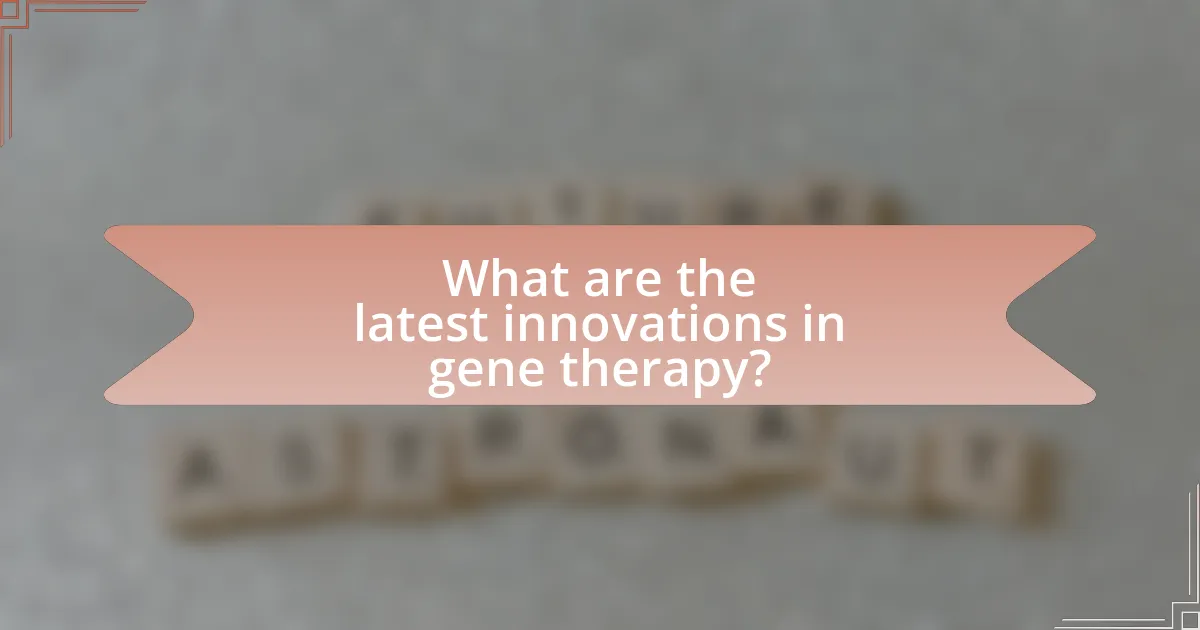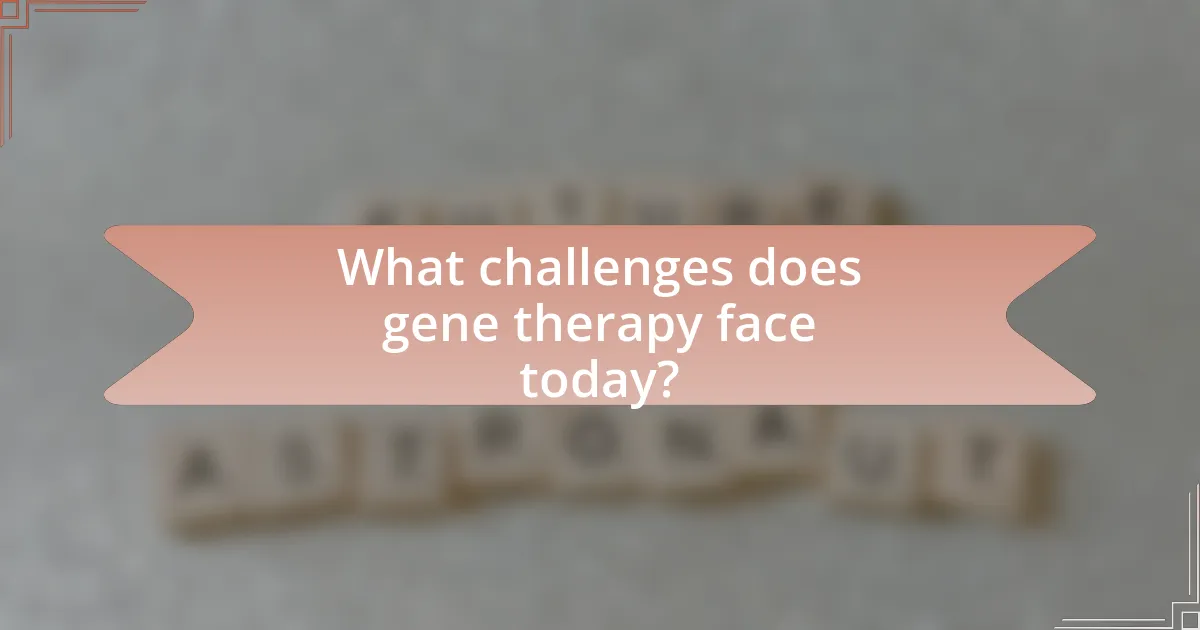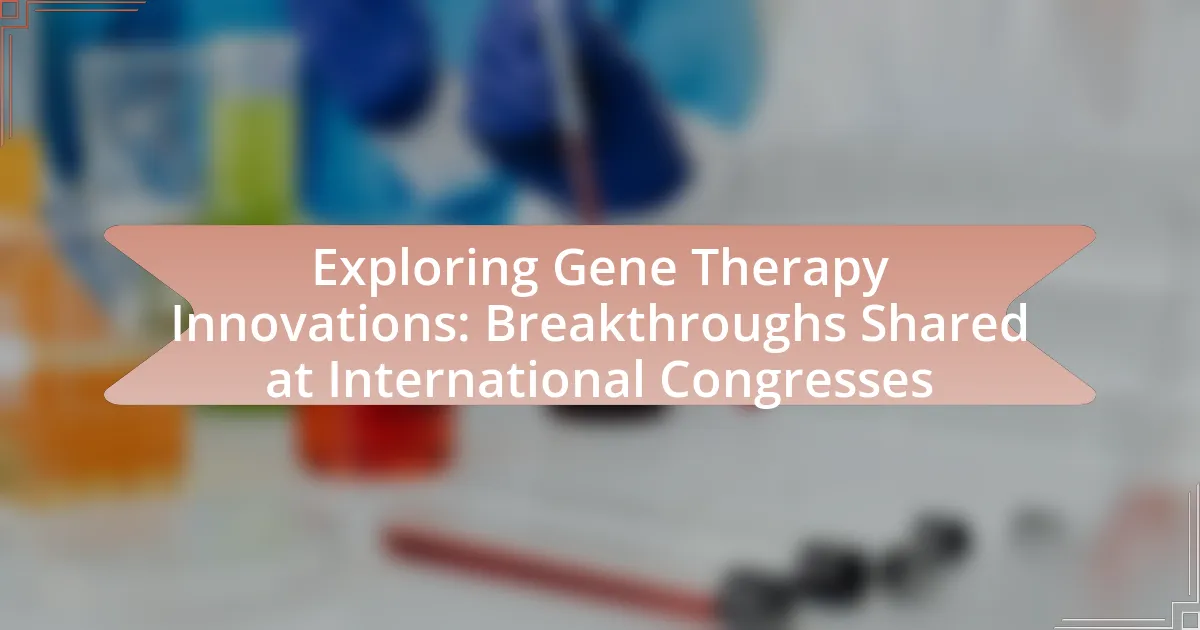The article focuses on the latest innovations in gene therapy, highlighting advancements in CRISPR technology, including base and prime editing, which enable precise genetic modifications. It discusses the transformative impact of these breakthroughs on treating genetic disorders, exemplified by successful clinical trials for conditions like sickle cell disease and spinal muscular atrophy. Additionally, the article examines the role of international congresses in facilitating knowledge sharing among researchers, the challenges faced by gene therapy, including safety concerns and high costs, and the ethical considerations surrounding these treatments. It concludes with insights into future trends and best practices for researchers in the field.

What are the latest innovations in gene therapy?
The latest innovations in gene therapy include advancements in CRISPR technology, particularly the development of base editing and prime editing, which allow for more precise genetic modifications without introducing double-strand breaks. These techniques have shown promise in treating genetic disorders such as sickle cell disease and beta-thalassemia, with clinical trials demonstrating significant efficacy and safety. For instance, a study published in the New England Journal of Medicine in 2021 reported successful outcomes in patients with sickle cell disease treated using CRISPR-based therapies, highlighting the potential for long-term remission. Additionally, the use of adeno-associated virus (AAV) vectors has improved the delivery of gene therapies, enabling targeted treatment for conditions like spinal muscular atrophy, where the FDA approved Zolgensma in 2019, showcasing the rapid evolution of gene therapy applications.
How have recent breakthroughs changed the landscape of gene therapy?
Recent breakthroughs have significantly transformed the landscape of gene therapy by enhancing precision, safety, and accessibility. Innovations such as CRISPR-Cas9 gene editing have allowed for targeted modifications in the genome, reducing off-target effects and increasing the efficacy of treatments for genetic disorders. Additionally, advancements in viral vector technology have improved the delivery mechanisms for therapeutic genes, making it possible to treat previously untreatable conditions. For instance, the approval of Zolgensma for spinal muscular atrophy exemplifies how these breakthroughs have led to successful outcomes in clinical settings, demonstrating the potential for gene therapy to address a wide range of diseases effectively.
What specific technologies are driving these breakthroughs?
Gene editing technologies, particularly CRISPR-Cas9, are driving breakthroughs in gene therapy innovations. CRISPR-Cas9 enables precise modifications of DNA, allowing for targeted treatment of genetic disorders. Additionally, advancements in viral vector technology, such as adeno-associated viruses (AAV), facilitate the delivery of therapeutic genes into patient cells effectively. These technologies have been validated through numerous clinical trials, demonstrating significant efficacy in treating conditions like sickle cell disease and muscular dystrophy, thus underscoring their transformative impact on gene therapy.
How do these innovations improve patient outcomes?
Innovations in gene therapy improve patient outcomes by providing targeted treatments that address the underlying genetic causes of diseases. These therapies can lead to significant reductions in disease symptoms, enhance quality of life, and in some cases, offer potential cures. For instance, clinical trials have demonstrated that gene therapies for conditions like spinal muscular atrophy have resulted in increased survival rates and improved motor function in patients. Additionally, advancements in delivery methods, such as viral vectors, ensure that therapeutic genes are effectively introduced into the patient’s cells, maximizing treatment efficacy.
What role do international congresses play in gene therapy advancements?
International congresses play a crucial role in advancing gene therapy by facilitating the exchange of knowledge, research findings, and innovative techniques among scientists, clinicians, and industry leaders. These events provide a platform for presenting cutting-edge research, discussing clinical trial results, and sharing best practices, which accelerates the translation of scientific discoveries into therapeutic applications. For instance, the annual meeting of the American Society of Gene & Cell Therapy showcases the latest advancements and fosters collaborations that can lead to new treatment strategies. Such gatherings not only enhance networking opportunities but also stimulate discussions that can lead to regulatory advancements and funding for gene therapy projects.
How do these events facilitate knowledge sharing among researchers?
International congresses facilitate knowledge sharing among researchers by providing a platform for direct interaction, collaboration, and dissemination of the latest findings in gene therapy. These events enable researchers to present their work through presentations and posters, fostering discussions that can lead to new insights and collaborations. For instance, the American Society of Gene and Cell Therapy Annual Meeting showcases cutting-edge research, allowing participants to engage with experts and peers, which enhances the collective understanding of gene therapy advancements. Additionally, networking opportunities at these congresses often result in partnerships that can drive future research initiatives, thereby amplifying the impact of shared knowledge.
What are some notable presentations from recent congresses?
Notable presentations from recent congresses on gene therapy innovations include Dr. Jennifer Doudna’s discussion on CRISPR advancements at the 2023 International Gene Therapy Congress, where she highlighted the potential of gene editing in treating genetic disorders. Additionally, Dr. Carl June presented groundbreaking results on CAR-T cell therapy at the 2023 American Society of Hematology Annual Meeting, showcasing significant improvements in patient outcomes for certain blood cancers. These presentations reflect the ongoing advancements and collaborative efforts in the field of gene therapy, underscoring the importance of these innovations in clinical applications.

What challenges does gene therapy face today?
Gene therapy faces significant challenges today, including safety concerns, high costs, and regulatory hurdles. Safety concerns arise from potential adverse effects, such as immune reactions or unintended genetic changes, which have been highlighted in clinical trials. High costs, often exceeding millions of dollars per patient, limit accessibility and affordability, as seen with therapies like Zolgensma, which is priced at around $2.1 million. Regulatory hurdles also pose challenges, as the approval process can be lengthy and complex, requiring extensive data on efficacy and safety, which can delay patient access to innovative treatments.
What are the ethical considerations surrounding gene therapy?
The ethical considerations surrounding gene therapy include issues of consent, equity, and potential long-term effects. Informed consent is crucial, as patients must fully understand the risks and benefits before undergoing treatment. Equity concerns arise from the possibility that gene therapy may only be accessible to wealthy individuals or countries, exacerbating existing health disparities. Additionally, the long-term effects of gene therapy are not fully understood, raising questions about unintended consequences on future generations. These considerations are supported by discussions in bioethics literature, such as the report by the National Academies of Sciences, Engineering, and Medicine, which emphasizes the importance of addressing these ethical dilemmas in the context of advancing gene therapy technologies.
How do regulations impact the development of gene therapies?
Regulations significantly impact the development of gene therapies by establishing safety, efficacy, and ethical standards that must be met before therapies can be approved for clinical use. Regulatory bodies, such as the U.S. Food and Drug Administration (FDA) and the European Medicines Agency (EMA), require extensive preclinical and clinical data to ensure that gene therapies do not pose undue risks to patients. For instance, the FDA’s guidance on gene therapy emphasizes the need for rigorous testing protocols, which can prolong the development timeline but ultimately aims to protect patient safety. Additionally, regulations can influence funding and investment in gene therapy research, as compliance with regulatory standards often requires substantial financial resources and expertise.
What are the potential risks associated with gene therapy?
The potential risks associated with gene therapy include immune reactions, insertional mutagenesis, and off-target effects. Immune reactions can occur when the body recognizes the introduced genetic material as foreign, leading to inflammation or rejection of the therapy. Insertional mutagenesis refers to unintended changes in the genome that can disrupt normal gene function, potentially leading to cancer. Off-target effects involve unintended modifications to other genes, which can result in harmful consequences. These risks highlight the need for thorough preclinical and clinical evaluations to ensure the safety and efficacy of gene therapy approaches.
How is funding influencing gene therapy research?
Funding significantly influences gene therapy research by providing essential financial resources that drive innovation and development. Increased funding enables researchers to conduct extensive clinical trials, which are crucial for validating the safety and efficacy of gene therapies. For instance, the global gene therapy market is projected to reach $13.3 billion by 2026, reflecting a surge in investment from both public and private sectors. This influx of capital supports advancements in technology, such as CRISPR and viral vector development, which are pivotal for successful gene editing. Furthermore, funding from organizations like the National Institutes of Health and private biotech firms has accelerated the pace of research, leading to breakthroughs that were previously unattainable.
What sources of funding are most significant for gene therapy innovations?
The most significant sources of funding for gene therapy innovations include government grants, venture capital investments, and pharmaceutical company partnerships. Government grants, such as those from the National Institutes of Health (NIH) in the United States, provide substantial financial support for research and development in gene therapy, often amounting to millions of dollars annually. Venture capital investments have surged in recent years, with firms investing billions into biotech startups focused on gene therapy, reflecting the high potential for returns in this rapidly advancing field. Additionally, pharmaceutical companies are increasingly forming partnerships with biotech firms, providing funding in exchange for rights to develop and commercialize new therapies, which can lead to multi-million dollar deals. These funding sources collectively drive innovation and advancement in gene therapy.
How does funding availability affect research priorities?
Funding availability significantly influences research priorities by directing resources toward projects that align with funding agency interests and societal needs. For instance, when substantial funding is allocated to gene therapy research, it often leads to increased focus on specific diseases or technologies that promise high impact, such as CRISPR-based therapies. This trend is evidenced by the National Institutes of Health (NIH) allocating over $1 billion to gene therapy research in 2020, which resulted in a surge of studies targeting genetic disorders like muscular dystrophy and hemophilia. Consequently, the availability of funding shapes the landscape of research by prioritizing areas that are financially supported, thereby determining which innovations are pursued and developed.

What future trends can we expect in gene therapy?
Future trends in gene therapy include the advancement of CRISPR technology, the development of personalized gene therapies, and the integration of artificial intelligence in treatment design. CRISPR technology is expected to become more precise, reducing off-target effects and enhancing therapeutic efficacy, as evidenced by ongoing clinical trials demonstrating its potential in treating genetic disorders. Personalized gene therapies will increasingly focus on tailoring treatments to individual genetic profiles, improving outcomes and minimizing adverse effects, supported by the growing body of research on genomics and patient-specific therapies. Additionally, artificial intelligence will play a crucial role in optimizing gene therapy protocols, predicting patient responses, and accelerating the discovery of new therapeutic targets, as highlighted by recent studies showcasing AI’s impact on drug development timelines.
How might gene therapy evolve in the next decade?
Gene therapy is expected to evolve significantly in the next decade through advancements in precision medicine, delivery mechanisms, and regulatory frameworks. Innovations such as CRISPR technology will enhance the ability to edit genes with greater accuracy, reducing off-target effects and improving patient outcomes. Additionally, the development of novel delivery systems, like nanoparticles and viral vectors, will facilitate more efficient and targeted gene delivery to specific tissues, increasing the effectiveness of treatments for genetic disorders. Regulatory bodies are also likely to adapt their frameworks to accommodate these advancements, streamlining the approval process for new therapies. This evolution is supported by ongoing clinical trials and research demonstrating the potential of gene therapies to treat previously untreatable conditions, as evidenced by the success of therapies like Zolgensma for spinal muscular atrophy and Luxturna for inherited retinal disease.
What emerging technologies could revolutionize gene therapy?
Emerging technologies that could revolutionize gene therapy include CRISPR-Cas9 gene editing, adeno-associated virus (AAV) vectors, and synthetic biology approaches. CRISPR-Cas9 allows for precise modifications of DNA, enabling targeted treatments for genetic disorders, as demonstrated in clinical trials for conditions like sickle cell disease. AAV vectors are being optimized for safer and more effective delivery of therapeutic genes, with recent studies showing improved efficacy in treating inherited retinal diseases. Additionally, synthetic biology is facilitating the design of novel gene circuits that can regulate gene expression dynamically, enhancing the therapeutic potential of gene therapies. These advancements are supported by ongoing research and clinical applications, indicating a transformative impact on the field of gene therapy.
How will patient access to gene therapies change?
Patient access to gene therapies will improve significantly due to advancements in technology and regulatory frameworks. Innovations such as CRISPR and other gene-editing techniques are making therapies more effective and less expensive to produce, which can lead to broader availability. Additionally, regulatory bodies are increasingly streamlining approval processes for these therapies, as seen with the FDA’s accelerated approval pathways, which can expedite access for patients with rare genetic disorders. These changes are expected to enhance the distribution and affordability of gene therapies, ultimately allowing more patients to benefit from these groundbreaking treatments.
What are the best practices for researchers in gene therapy?
Best practices for researchers in gene therapy include adhering to rigorous ethical standards, ensuring robust preclinical testing, and maintaining transparency in data reporting. Ethical standards are crucial as they guide researchers in obtaining informed consent and addressing potential risks to participants. Robust preclinical testing, which involves thorough evaluation in animal models, is essential to assess the safety and efficacy of gene therapies before human trials. Transparency in data reporting fosters trust and reproducibility, allowing other researchers to validate findings and build upon them. These practices are supported by guidelines from organizations such as the American Society of Gene & Cell Therapy, which emphasizes the importance of ethical considerations and scientific rigor in advancing gene therapy research.
How can researchers effectively collaborate across disciplines?
Researchers can effectively collaborate across disciplines by establishing clear communication channels and shared goals. This approach fosters mutual understanding and aligns diverse expertise towards common objectives. For instance, interdisciplinary teams in gene therapy have successfully integrated insights from molecular biology, genetics, and clinical medicine, leading to innovative treatment strategies. A study published in the journal “Nature Biotechnology” highlights that collaborative projects involving multiple disciplines can accelerate the pace of research and enhance the quality of outcomes, demonstrating that structured collaboration is essential for advancing complex fields like gene therapy.
What strategies can enhance the translation of research into clinical applications?
Strategies that can enhance the translation of research into clinical applications include fostering collaboration between researchers and clinicians, implementing robust regulatory frameworks, and utilizing patient-centered approaches. Collaboration ensures that research findings are aligned with clinical needs, as evidenced by initiatives like the National Institutes of Health’s Clinical and Translational Science Awards, which promote partnerships between academic institutions and healthcare providers. Robust regulatory frameworks streamline the approval process for new therapies, as seen in the expedited pathways established by the FDA for breakthrough therapies. Patient-centered approaches, such as involving patients in the research process, improve the relevance and applicability of findings, demonstrated by studies showing increased patient engagement leads to better health outcomes.


